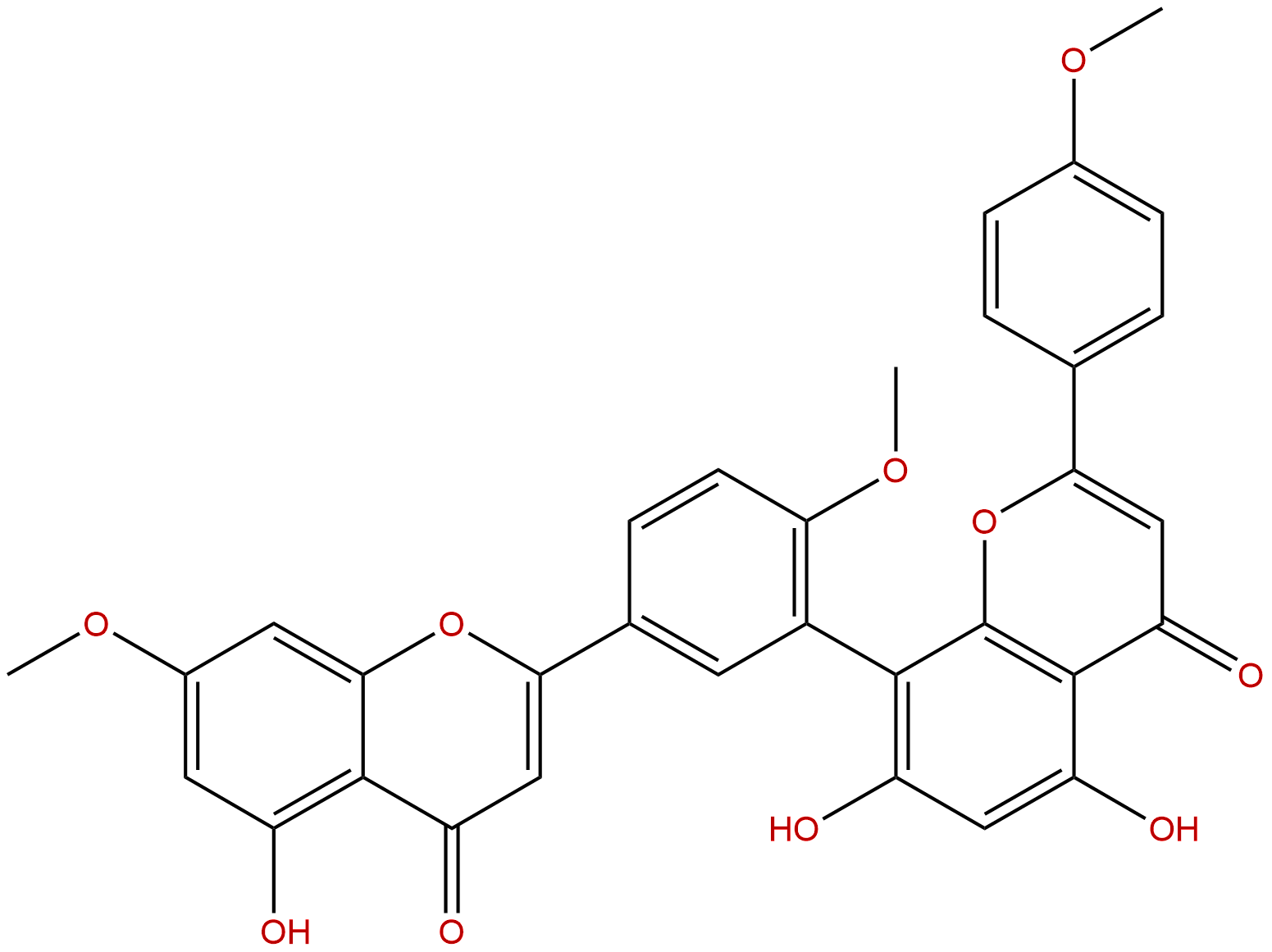
SciadopitysinCAS No.:521-34-6
|
||||||||||
 |
|
|
||||||||

| Catalogue No.: | BP1269 |
| Formula: | C33H24O10 |
| Mol Weight: | 580.545 |
Product name: Sciadopitysin
Synonym name:
Catalogue No.: BP1269
Cas No.: 521-34-6
Formula: C33H24O10
Mol Weight: 580.545
Botanical Source: Ginkgo biloba L.
Physical Description:
Type of Compound: Flavonoids
Purity: 95%~99%
Analysis Method: HPLC-DAD or/and HPLC-ELSD
Identification Method: Mass, NMR
Packing: Brown vial or HDPE plastic bottle
Storage: Store in a well closed container, protected from air and light. Put into refrigerate or freeze for long term storage.
Whenever possible, you should prepare and use solutions on the same day. However, if you need to make up stock solutions in advance, we recommend that you store the solution as aliquots in tightly sealed vials at -20℃. Generally, these will be useable for up to two weeks.
The product could be supplied from milligrams to grams
Inquire for bulk scale.
Description:
Sciadopitysin shows protective effects on antimycin A-induced toxicity in osteoblastic MC3T3-E1 cells, it may reduce or prevent osteoblasts degeneration; it also may prevent the development of diabetic osteopathy, it exerts its therapeutic effects via upregulation of mitochondrial biogenesis. Sciadopitysin can inhibit the Aβ aggregation and reduce Aβ-induced toxicity in the primary cortical neurons.
References:
Free Radic Res. 2014 Jul;48(7):729-39.
Sciadopitysin alleviates methylglyoxal-mediated glycation in osteoblastic MC3T3-E1 cells by enhancing glyoxalase system and mitochondrial biogenesis.
Methylglyoxal (MG) is a precursor of advanced glycation end products, which contribute to diabetic complications, including bone defects.
METHODS AND RESULTS:
In the present study, the effect of Sciadopitysin on MG-induced cytotoxicity was investigated using osteoblastic MC3T3-E1 cells. Pretreatment of MC3T3-E1 cells with Sciadopitysin prevented the MG-induced cell death and protein adducts formation. Sciadopitysin restored the MG-induced change in glyoxalase activity almost to the control level and increased glutathione levels. In addition, Sciadopitysin decreased MG-induced formation of intracellular reactive oxygen species (ROS), mitochondrial superoxide, and cardiolipin peroxidation. These findings suggest that Sciadopitysinprovides a protective action against MG-induced glycation by increasing MG detoxification system and by reducing oxidative stress. Pretreatment with Sciadopitysin prior to MG exposure reduced MG-induced mitochondrial dysfunction by preventing mitochondrial membrane potential (MMP) dissipation and adenosine triphosphate (ATP) loss. The nitric oxide (NO) level was decreased by MG treatment, but it was significantly increased by Sciadopitysin, suggesting that Sciadopitysin may induce NO-dependent mitochondrial biogenesis. Furthermore, Sciadopitysin treatment increased the levels of sirtuin 1 (SIRT1), peroxisome proliferator-activated receptor gamma coactivator 1 alpha (PGC-1α), nuclear respiratory factor 1 (NRF-1), and mitochondrial transcription factor A (TFAM).
CONCLUSIONS:
These findings indicate that Sciadopitysin might exert its therapeutic effects via upregulation of mitochondrial biogenesis. Therefore, Sciadopitysin may prevent the development of diabetic osteopathy.
Nat Prod Res. 2013;27(22):2157-60.
Sciadopitysin: active component from Taxus chinensis for anti-Alzheimer's disease.
METHODS AND RESULTS:
Five taxane diterpenoids derived from the 95% ethanol extract of Taxus chinensis were tested for the inhibitory activities on amyloid-beta (Aβ) peptide aggregation. Using thioflavin-T fluorescence assay, Sciadopitysin was found to exhibit the most potency against Aβ aggregation and the formation of fibrils. Further cellular assay indicated that Sciadopitysin increased the cell viability of SH-SY5Y cell and demonstrated neuroprotection against Aβ protein-induced insult in primary cortical neurons.
CONCLUSIONS:
According to the authors' best knowledge, this is the first report that Sciadopitysin can inhibit the Aβ aggregation and reduce Aβ-induced toxicity in the primary cortical neurons.